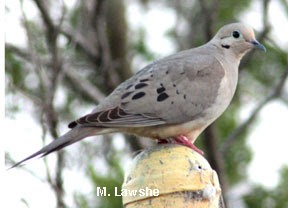Are Mourning Doves Good Pets? This is a common question explored by PETS.EDU.VN for bird enthusiasts curious about keeping these gentle birds. Discover if these peaceful birds make suitable companions and learn about ethical considerations and necessary care. Uncover if keeping these gentle birds as pets is right for you, covering various aspects such as legality, welfare, and alternatives for enjoying these birds.
1. Understanding Mourning Doves
Mourning doves (Zenaida macroura) are graceful, slender birds belonging to the dove family, Columbidae. Their soothing, melancholic cooing is a familiar sound across North America. These birds are known for their gentle nature and adaptability, thriving in diverse habitats from open woodlands and fields to suburban and urban areas.
Mourning doves have a distinctive appearance, with soft gray-brown plumage, black spots on their wings, and a long, pointed tail. Their eyes are dark and expressive, often surrounded by a delicate blue eye-ring. Adults typically measure between 11 to 13 inches in length and weigh around 4 to 6 ounces.
Their diet primarily consists of seeds, which they forage for on the ground. They are also known to consume grains, berries, and occasionally insects. Mourning doves are ground feeders, often seen in pairs or small flocks, meticulously pecking at seeds and small grains.
1.1 Natural Habitat and Behavior
Mourning doves thrive in a variety of habitats, including open woodlands, grasslands, suburban gardens, and even urban parks. They are well-adapted to living near humans, often frequenting bird feeders and open areas where seeds are readily available.
These birds are known for their monogamous relationships, often mating for life. They are prolific breeders, capable of raising multiple broods per year, typically laying two eggs per clutch. Nests are usually built in trees or shrubs, but they may also nest on the ground or in other sheltered locations.
Mourning doves exhibit a distinctive flight pattern, characterized by rapid wingbeats and direct flight. They are strong fliers and can reach speeds of up to 55 miles per hour. Their call, a soft, drawn-out “coo-oo-oo,” is often heard during the early morning and late afternoon, adding a tranquil element to their environment.
1.2 Conservation Status
Mourning doves are one of the most abundant bird species in North America. According to the North American Breeding Bird Survey, their population is estimated to be around 350 million. However, despite their abundance, mourning doves face several threats, including habitat loss, hunting, and collisions with vehicles and buildings.
These birds are popular game birds in many states, with hunting seasons regulated to ensure sustainable populations. Conservation efforts, such as habitat preservation and responsible hunting practices, are crucial for maintaining healthy mourning dove populations for future generations.
 Mourning Dove Perched
Mourning Dove Perched
2. Legal Aspects of Keeping Mourning Doves as Pets
Before considering a mourning dove as a pet, it’s essential to understand the legal implications. Laws regarding the possession of wild birds vary significantly by country, state, and local jurisdictions.
2.1 Federal and State Laws in the United States
In the United States, the Migratory Bird Treaty Act (MBTA) of 1918 protects mourning doves and other migratory birds. This act makes it illegal to take, possess, import, export, sell, purchase, or barter any migratory bird, their eggs, parts, or nests, except under a valid permit issued by the U.S. Fish and Wildlife Service.
This means that keeping a mourning dove as a pet is generally illegal without the proper permits. Violations of the MBTA can result in significant fines and even imprisonment. State laws further regulate the possession of wildlife, and these laws may be even stricter than federal regulations.
For example, some states may allow the possession of certain native birds only for rehabilitation purposes, requiring special permits and facilities. It is crucial to check both federal and state laws to ensure compliance and avoid legal issues.
2.2 International Laws
Laws regarding the possession of wild birds vary widely across different countries. Some countries have strict regulations similar to the MBTA, while others may have more lenient rules. It’s essential to research the specific laws in your country or region before considering keeping a mourning dove as a pet.
In some areas, permits may be available for keeping native birds for educational or conservation purposes. However, these permits typically require meeting specific criteria and adhering to strict guidelines.
2.3 Consequences of Illegal Possession
The consequences of illegally possessing a mourning dove can be severe. Fines can range from hundreds to thousands of dollars, depending on the jurisdiction and the severity of the violation. In some cases, individuals may face criminal charges, resulting in jail time.
Additionally, illegally possessed birds may be confiscated by wildlife authorities and released back into the wild or placed in a licensed rehabilitation facility. It’s essential to respect wildlife laws and regulations to protect native bird populations and avoid legal repercussions.
3. Ethical Considerations
Beyond the legal aspects, there are significant ethical considerations when deciding whether to keep a mourning dove as a pet. These birds are adapted to living in the wild, and their welfare should be a primary concern.
3.1 Impact on Wild Populations
Removing a mourning dove from its natural habitat can have negative impacts on wild populations. Even taking a single bird can disrupt local ecosystems and reduce the genetic diversity of the population.
Mourning doves play an important role in seed dispersal and maintaining ecological balance. Removing them can disrupt these processes and harm the overall health of the environment.
3.2 Welfare of Captive Birds
Mourning doves have specific needs that are difficult to meet in a captive environment. They require ample space to fly and forage, a varied diet, and social interaction with other doves.
Captive birds may suffer from stress, boredom, and malnutrition if their needs are not adequately met. They may also develop behavioral problems, such as feather plucking or repetitive movements.
Confined spaces limit their natural behaviors, which can lead to significant distress. Ethical considerations require prioritizing the bird’s well-being and natural behaviors.
3.3 Alternatives to Keeping as Pets
There are many ways to enjoy mourning doves without keeping them as pets. Supporting local wildlife rehabilitation centers, creating bird-friendly habitats in your backyard, and participating in citizen science projects are all great ways to connect with these birds in a responsible and ethical manner.
Providing food, water, and shelter for wild birds can attract them to your property, allowing you to observe and appreciate their natural behavior without disrupting their lives.
4. Challenges of Caring for Mourning Doves in Captivity
Even if it were legal and ethical to keep a mourning dove as a pet, providing proper care for these birds in captivity presents numerous challenges.
4.1 Housing Requirements
Mourning doves require a spacious aviary or flight cage to allow them to fly and exercise. The cage should be large enough for them to fly short distances and should provide plenty of perches, branches, and hiding places.
The aviary should be protected from extreme weather conditions and predators. It should also be kept clean and free from hazards.
Here is a sample table for housing requirements:
| Requirement | Description |
|---|---|
| Size | Minimum of 8 feet long, 4 feet wide, and 6 feet high for a pair of doves. |
| Materials | Sturdy wire mesh or netting, wooden or metal frame. |
| Perches | Various sizes and materials (natural branches, wooden dowels). |
| Protection | Shelter from wind, rain, and direct sunlight. |
| Safety | Secure against predators (cats, dogs, rodents). |
| Cleaning | Regular cleaning to remove droppings and food waste. |
| Enrichment | Provide toys, dust baths, and opportunities for foraging. |
| Location | Quiet area, away from high traffic and potential stressors. |
4.2 Dietary Needs
Mourning doves have a specialized diet consisting primarily of seeds. In captivity, they should be fed a high-quality seed mix formulated for doves and pigeons.
They also require access to grit, which helps them digest seeds. Fresh water should always be available.
Supplementing their diet with small amounts of fresh fruits, vegetables, and insects can provide additional nutrients.
Here is a sample diet plan:
| Food Type | Description |
|---|---|
| Seed Mix | Commercial dove and pigeon seed mix (e.g., millet, sorghum, sunflower seeds). |
| Grit | Insoluble grit (e.g., granite) to aid digestion. |
| Fresh Water | Clean, fresh water available at all times. |
| Fruits/Vegetables | Small amounts of chopped greens (e.g., spinach, kale) and fruits (e.g., berries, apple pieces). |
| Insects | Occasional mealworms or crickets for added protein. |
4.3 Social Interaction
Mourning doves are social birds and thrive in the company of other doves. Keeping them alone can lead to loneliness and depression.
If you are considering keeping mourning doves in captivity, it’s best to keep them in pairs or small groups. This will allow them to engage in natural social behaviors, such as preening and cooing.
4.4 Health Concerns
Mourning doves are susceptible to a variety of health problems, including avian pox, parasites, and respiratory infections. Regular veterinary care is essential to maintaining their health.
Signs of illness in mourning doves may include lethargy, loss of appetite, ruffled feathers, and discharge from the eyes or nose. If you notice any of these signs, seek veterinary attention immediately.
Here is a sample table of common health concerns:
| Health Issue | Symptoms |
|---|---|
| Avian Pox | Wart-like lesions on the skin, especially around the eyes, beak, and feet. |
| Parasites | Feather plucking, weight loss, diarrhea. |
| Respiratory Infections | Sneezing, coughing, nasal discharge, difficulty breathing. |
| Coccidiosis | Diarrhea (often bloody), weight loss, lethargy. |
| Newcastle Disease | Neurological signs (e.g., tremors, paralysis), respiratory distress. |
4.5 Difficulty Releasing Back to the Wild
Once a mourning dove has been kept in captivity, it may be difficult or impossible to release it back into the wild. Captive birds may lose their natural instincts and become dependent on humans for food and shelter.
They may also be more susceptible to predators and diseases. Releasing a captive bird into the wild can be detrimental to its survival.
5. Enjoying Mourning Doves Responsibly
Instead of keeping mourning doves as pets, there are many ways to enjoy these birds responsibly and ethically.
5.1 Creating Bird-Friendly Habitats
Creating a bird-friendly habitat in your backyard can attract mourning doves and other native birds. Plant native trees, shrubs, and flowers that provide food and shelter.
Provide a source of fresh water, such as a birdbath or small pond. Avoid using pesticides or herbicides, which can harm birds and other wildlife.
5.2 Bird Feeding
Offering a variety of seeds in bird feeders can attract mourning doves to your property. Use feeders that are designed for ground-feeding birds, such as platform feeders or seed scattered on the ground.
Clean feeders regularly to prevent the spread of disease. Offer a variety of seeds, such as sunflower seeds, millet, and cracked corn.
5.3 Bird Watching
Bird watching is a great way to observe and appreciate mourning doves in their natural habitat. Use binoculars to get a closer look at their behavior and plumage.
Keep a field guide handy to help you identify different bird species. Respect birds’ space and avoid disturbing their nests or habitats.
5.4 Supporting Conservation Efforts
Supporting local and national conservation organizations can help protect mourning doves and their habitats. Donate to organizations that work to preserve natural areas and promote responsible wildlife management.
Participate in citizen science projects, such as bird counts and habitat surveys. Educate others about the importance of bird conservation.
6. Addressing Common Misconceptions
There are several common misconceptions about keeping mourning doves as pets. Addressing these misconceptions can help people make informed decisions about their interactions with these birds.
6.1 “They Are Easy to Care For”
While mourning doves may seem like low-maintenance pets, they require specialized care and attention. Meeting their housing, dietary, and social needs can be challenging, especially for inexperienced bird owners.
6.2 “They Will Be Happier in Captivity”
Mourning doves are adapted to living in the wild and are generally happier and healthier in their natural environment. Captivity can be stressful and detrimental to their well-being.
6.3 “I Can Rescue and Rehabilitate Them Myself”
Rescuing and rehabilitating injured or orphaned mourning doves requires specialized knowledge and skills. It’s best to leave this to trained professionals who have the resources and expertise to provide proper care.
7. Expert Opinions on Keeping Wild Birds
Veterinarians and wildlife experts generally advise against keeping wild birds as pets. They emphasize the importance of respecting wildlife and allowing birds to live in their natural habitats.
7.1 Veterinarian Perspectives
Veterinarians specializing in avian medicine highlight the challenges of providing proper care for wild birds in captivity. They note that wild birds have unique nutritional and environmental needs that are difficult to replicate in a domestic setting.
Veterinarians also caution against the potential for disease transmission between wild birds and domestic pets.
7.2 Wildlife Rehabilitator Insights
Wildlife rehabilitators emphasize the importance of releasing rescued birds back into the wild whenever possible. They work to rehabilitate injured or orphaned birds and prepare them for a successful return to their natural habitat.
Rehabilitators caution against the dangers of imprinting, where young birds become dependent on humans and lose their ability to survive in the wild.
8. Case Studies: Failed Attempts at Keeping Mourning Doves
Numerous case studies illustrate the challenges and negative outcomes of keeping mourning doves as pets. These examples highlight the importance of considering the bird’s welfare and respecting its natural instincts.
8.1 Case Study 1: Neglect and Malnutrition
A family attempted to keep a rescued mourning dove as a pet, but they were unable to provide proper housing and nutrition. The bird suffered from malnutrition and developed severe feather plucking due to stress.
8.2 Case Study 2: Behavioral Problems
An individual raised a mourning dove from a young age, but the bird developed behavioral problems, such as aggression and excessive vocalization. The bird was eventually surrendered to a wildlife rehabilitation center.
8.3 Case Study 3: Inability to Release
A person kept a mourning dove in captivity for several years, but the bird became too accustomed to human interaction and was unable to survive when released back into the wild.
9. PETS.EDU.VN’s Stance on Wild Animals as Pets
At PETS.EDU.VN, we strongly advocate for the ethical treatment of all animals, including wild birds. We believe that wild animals should be allowed to live in their natural habitats and that their welfare should be a primary concern.
We do not support the keeping of wild animals as pets, as it can have negative impacts on both the individual animal and the wild population. We encourage people to enjoy mourning doves and other native birds responsibly, by creating bird-friendly habitats, bird watching, and supporting conservation efforts.
10. Conclusion: Respecting Wildlife and Making Informed Choices
In conclusion, while the gentle nature of mourning doves may make them seem like appealing pets, it’s crucial to consider the legal, ethical, and practical challenges of keeping them in captivity. The Migratory Bird Treaty Act and similar laws protect these birds, making it illegal to possess them without proper permits.
Ethically, removing a mourning dove from its natural habitat can harm wild populations and compromise the bird’s welfare. The specialized care these birds require, including spacious aviaries, specific diets, and social interaction, is difficult to provide in a domestic setting.
Instead of keeping mourning doves as pets, we encourage you to enjoy them responsibly by creating bird-friendly habitats, bird watching, and supporting conservation efforts. By respecting wildlife and making informed choices, we can help ensure that these beautiful birds continue to thrive in their natural environment for generations to come.
PETS.EDU.VN is committed to providing accurate and reliable information about pet care and animal welfare. We encourage you to explore our website for more resources on responsible pet ownership and wildlife conservation.
For more information on bird care and conservation, visit PETS.EDU.VN or contact us at 789 Paw Lane, Petville, CA 91234, United States. You can also reach us via WhatsApp at +1 555-987-6543.
FAQ: Mourning Doves as Pets
1. Is it legal to keep a mourning dove as a pet?
No, it is generally illegal in the United States and many other countries without proper permits, due to laws like the Migratory Bird Treaty Act.
2. What are the ethical concerns of keeping mourning doves as pets?
It can negatively impact wild populations, compromise the bird’s welfare, and limit their natural behaviors.
3. What kind of housing do mourning doves need in captivity?
They require a spacious aviary or flight cage with plenty of perches, branches, and hiding places.
4. What do mourning doves eat?
Their diet primarily consists of seeds, supplemented with grit, fresh water, and occasional fruits, vegetables, and insects.
5. Are mourning doves social birds?
Yes, they thrive in the company of other doves and can suffer from loneliness if kept alone.
6. What are some common health concerns for mourning doves in captivity?
Avian pox, parasites, respiratory infections, coccidiosis, and Newcastle disease.
7. Can I release a mourning dove back into the wild after keeping it as a pet?
It is generally not recommended, as captive birds may lose their natural instincts and become dependent on humans.
8. What are some responsible ways to enjoy mourning doves?
Creating bird-friendly habitats, bird watching, bird feeding, and supporting conservation efforts.
9. What should I do if I find an injured mourning dove?
Contact a local wildlife rehabilitation center or animal rescue organization for assistance.
10. Where can I find more information on bird care and conservation?
Visit pets.edu.vn or contact wildlife conservation organizations for resources and support.


